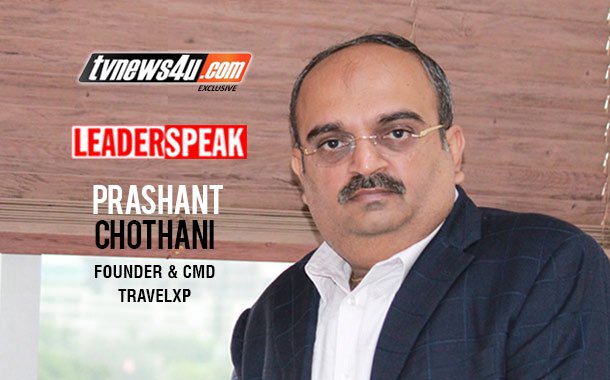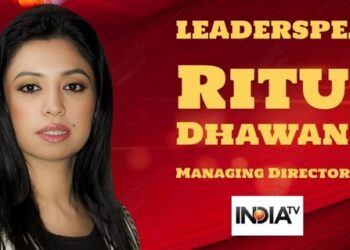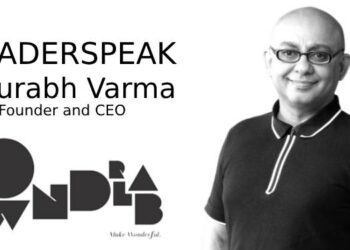By Yohan P Chawla
Presenting Part 2 of LEADERSPEAK with Prashant Chothani, Co-founder and CMD of the world’s leading travel channel, Travelxp. In this, the concluding part, he discusses the UK model of television ad sales, which he believes would benefit both, the broadcaster and the brands alike, and says it is high time the industry be driven by the reality of numbers and get together to close the ‘doors for perception-based judgemental calls’ when buying and selling media, especially television air time. This, and more in part 2 of LEADERSPEAK with Prashant Chothani…
What has Travelxp’s overall contribution been in promoting tourism to and from India?
We believe that Travelxp is the world’s biggest travel influencer. With 100% travel content, viewers would have definitely taken advantage of seeing new places and then visiting them. When you see more, you explore more. Though we can’t measure exactly what and how much contribution to the growth of domestic and inbound tourism is due to Travelxp, I am sure we have influenced it.
Isn’t the UK model of ad sales — of paying the broadcaster on the basis of the actual eyeballs delivered — a much better way of selling advertising inventory than what is followed in India, especially when BARC is now much bigger and wider sample size and doing great work to grow and evangelize the ad buying industry though it still has miles to do? Would you support a UK ad Sales model — paying not on pre-agreed, perception-driven rates, but for the actual delivery of eyeballs?
It should have been the only way of selling or buying, but unfortunately this shift in science is taking far too long. If you see digital, it is purely bought on CPM. Then why not TV? It would be interesting to map prevailing CPM rates of digital to TV impressions and see what is throws up.
If the mathematics of the science is defined, like in the UK or many western markets, it closes doors for perception-based judgemental calls. It also closes doors for discretion.
You can’t have subjective calls made by a person or a group of people, in deciding how ad dollars will be spent! Ultimately you are buying eyeballs, and perceptions are your own, which are away from reality.

Reality are the numbers. If you need to reach adults only, this is the price. If you need a segmented audience, say ABC 2+ then this is the price. If you need programmatic audience, say food or travel audience, this is the price. There are premium rates for categories of clients depending on the genre of the channel and the audience it would deliver to. Even these are known and fixed transparently. This would make life much more simple, accountable and logical.
We all know that the existence of BARC was to move to an impressions-based revenue rather than CPRP. I don’t know how much the industry has progressed to achieve this objective. BARC has done its part of work by constantly expanding the sample size so that the extrapolation is as close as possible to reality. If the Broadcast Industry does not get this fixed early, it would delegate the monetization benefits to other mediums including Digital.

As a broadcaster you could actually help set this trend in India.
It can’t be done just by Travelxp setting the trend. It must be a collective effort of the industry. It is in the interest of not only the broadcasters but also for brands. I am surprised that it has taken so long and even today we are not even trying.
Speaking of setting trends, you have been acknowledged as one of the foremost thinkers and evangelists in the 4K and 4K HDR space of broadcast technology. You even gave the world its first 4K HDR channel and are on the Ultra HD Forum to take this ecosystem further. How and when did you first get interested in the 4K technology of broadcast? Was it just as a broadcaster who wanted to shoot and air in the best possible quality? Did you have a tech qualification to support your quest for 4K knowledge? Please do share in detail as this would be interesting and inspiration for our readers.
Let me put it this way: we started producing HD content from 2008. Not many had visualized the state of HD adoption — not only in India but across the world back then.

We always wanted to be technologically superior and disruptive. Travel as a genre allowed the flexibility to do it as well. If you need to be a global media brand, as an Indian company you need to have a head-start. You need to be in the innovation cycle of media technology so that you are accepted when time for adoption comes. This is exactly what we did with 4K.
Technologically I may not have a degree, but my learning over time and my constant resolve to keep myself updated and educated with what is happening and what is going to happen in the media and technology space allows me to envisage the future. I spend an hour or two daily just on educating myself.
I remember when we were going through this 4K HDR phase of innovation, Mr. Anil Khera, who was then the CEO of Videocon D2h, told me that it is almost impossible to get a chance to do ´world’s first´ especially in the media and tech space. He pushed me and said, ‘Do it, and as an Indian, I would be very proud the day it is done’. It was very encouraging!
When in 2015 we realized that 4K HDR would be the future, we realised that Travel would be a key genre. It had the ability and potential to provide the vivid immersive experience which would make 4K HDR more relevant than HD. If you see the specifications of 4K HDR, it is 50 frames (vs the 25 we use today), progressive (vs interlaced we use today), 10-bit color (vs 8-bit that we use today), REC2020 color space (vs REC 709 that we use today), at least 12.5 stops of Dynamic Range (vs 6-7 we see today) and 1000 nits of brightness (vs 75-300 we use today), which is a huge game changer.

It is challenging as a content producer, especially if you are in the television space. Your entire work-flow changes and so does your entire chain. Not only does it change on the production side, it also does through the contribution, distribution and consumer side as well. Everything has to be changed for adoption.
I would, however, caution that not every type of content genre would make a significant visible impact in 4K HDR. It is a format which brings physical change to make a person see and experience on television what he or she sees with the naked eye. It is bridging that gap of eye vision to TV vision.
I have been a regular speaker at several global conferences, seminars and events for 4K where majority of the discussions are technical in nature. I feel proud as an Indian to have achieved such a milestone; having placed our country on a global platform. We have also been recognized and awarded by Eutels at as a 4K Innovation Partner in recognition of ‘Outstanding Contribution to 4K Ultra HD’.
















